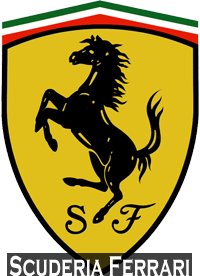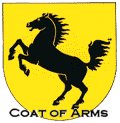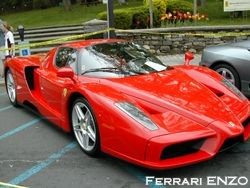|
|
| Ferrari |
| Wednesday, April 05, 2006 |

Ferrari
Ferrari is an Italian constructor in the Formula One World Championship, as well as a manufacturer of high-end and high-performance race cars, exotic cars, and sports cars formed by Enzo Ferrari in 1929. At first, Scuderia Ferrari sponsored drivers and manufactured racecars; the company went into independent car production in 1946, eventually became Ferrari S.p.A., and is now controlled by the Fiat group. The company is based in Maranello, near Modena, Italy.
History1929-1946
Enzo Ferrari never intended to produce road cars when he formed Scuderia Ferrari in 1929 as a sponsor for amateur drivers headquartered in Modena. Ferrari prepared and successfully raced various drivers in Alfa Romeo cars until 1938, when he was officially hired by Alfa as head of their racing department.
In 1940, upon learning of the company's plan to absorb his beloved Scuderia and take control of his racing efforts, he quit Alfa. Because he was prohibited by contract from racing for several years, the Scuderia briefly became Auto Avio Costruzioni Ferrari, which ostensibly produced machine tools and aircraft accessories. Also known as SEFAC Ferrari did in fact produce one racecar, the Tipo 815, in the non-competition period; it was thus the first actual Ferrari car (it debuted at the 1940 Mille Miglia), but due to World War II it saw little competition. In 1943 the Ferrari factory moved to Maranello, where it has remained ever since. The factory was bombed in 1944 and rebuilt in 1946 to include a works for road car production. Right up to Il Commendatore's death, this would remain little more than a source of funding for his first love, racing.
"Scuderia Ferrari" literally means "Ferrari Stable" in keeping with the prancing horse emblem; the name is figuratively translated as "Team Ferrari." (It is correctly pronounced "skoo dee ry ah".)
1945-present
The first Ferrari road car was the 1947 125 S, powered by a 1.5 L V12 engine; Enzo reluctantly built and sold his automobiles to fund the Scuderia. While his beautiful and blazingly fast cars quickly gained a reputation for excellence, Enzo maintained a famous distaste for his customers, most of whom he felt were buying his cars for the prestige and not the performance.
Ferrari road cars, noted for magnificent styling by design houses like Pininfarina, have long been one of the ultimate accessories for the rich. Other design houses that have done work for Ferrari over the years include Scaglietti, Bertone, Touring, Ghia, and Vignale.
As of 2004, FIAT owns 56% of Ferrari, Mediobanca 15%, Commerzbank 10%, Lehman Brothers 7%, and Enzo's son Piero Ferrari 10%.
Racing
Enzo Ferrari's true passion, despite his extensive road car business, was always auto racing. His Scuderia started as an independent sponsor for drivers in various cars, but soon became the Alfa Romeo in-house racing team. After Ferrari's departure from Alfa, he began to design and produce cars of his own; the Ferrari team first appeared on the European grand prix scene after the end of World War II.
The Scuderia joined the Formula One World Championship in the first year of its existence, 1950. José Froilán González gave the team its first victory at the 1951 British Grand Prix. Alberto Ascari gave Ferrari its first World Championship a year later. Ferrari is the oldest team left in the championship, not to mention the most successful: the team holds nearly every Formula One record. As of 2004, the team's records include fourteen World Drivers Championship titles (1952, 1953, 1956, 1958, 1961, 1964, 1975, 1977, 1979, 2000, 2001, 2002, 2003 and 2004), fourteen World Constructors Championship titles (1961, 1964, 1975, 1976, 1977, 1979, 1982, 1983, 1999, 2000, 2001, 2002, 2003 and 2004), 179 grand prix victories, 3445 and a half points, 544 podium finishes, 174 pole positions, 11,182 laps led, and 180 fastest laps in 1622 grands prix contested.
Famous drivers include Tazio Nuvolari, Juan Manuel Fangio, Alberto Ascari, Phil Hill, Mike Hawthorn, John Surtees, Niki Lauda, Jody Scheckter, Gilles Villeneuve, Gerhard Berger, Nigel Mansell, Alain Prost, Jean Alesi and Michael Schumacher.
The "Cavallino Rampante"
The famous symbol of the Ferrari race team is a black prancing horse on yellow shield-shaped background, usually with the letters S F for Scuderia Ferrari, and with three stripes of the Italian national colors green-white-red on top. The road cars have a rectangular badge on the bonnet.
Curiously, a similar black horse on a yellow shield is the Coat of Arms of the German city of Stuttgart. This name is derived from Stutengarten, an ancient form of the modern German word Gestüt, which translates into English as stud farm and into Italian as scuderia. Stuttgart, called Stoccarda by the Italians, is the home of Mercedes-Benz and Ferrari's rival Porsche, which also uses the Stuttgart sign in its corporate logo, centred in the emblem of the state of Württemberg just like the city is placed within the state. Enzo Ferrari met these competitors many times since the 1920s while competing for Alfa.
On June 17, 1923, Enzo Ferrari won a race at the Savio track in Ravenna where he met the Countess Paolina, mother of Count Francesco Baracca, a legendary asso (ace) of the Italian air force and national hero during World War I, who used to paint a horse on the side of his planes. The Countess asked Enzo to use this horse on his cars, suggesting that it would grant him good luck. Ferrari left the horse black as it had been on Baracca's plane; however, he added a canary yellow background as this is the color of the city of Modena, his birthplace. It has been supposed the choice of a horse was perhaps partly because his noble family was known for having many horses on their estates at Lugo di Romagna. Another theory suggests Baracca copied the rampant horse design from a shot-down German pilot who had the emblem of the city of Stuttgart on his plane. This is supported by the evidence Barraca's horse looks more similar to the one of Stuttgart (not changed since 1938) than the current Ferrari design, especially as the legs of the horses are concerned. Baracca using the Stuttgart horse from a shot-down plane ties in with the fact that his family owned many horses. force and national hero during World War I, who used to paint a horse on the side of his planes. The Countess asked Enzo to use this horse on his cars, suggesting that it would grant him good luck. Ferrari left the horse black as it had been on Baracca's plane; however, he added a canary yellow background as this is the color of the city of Modena, his birthplace. It has been supposed the choice of a horse was perhaps partly because his noble family was known for having many horses on their estates at Lugo di Romagna. Another theory suggests Baracca copied the rampant horse design from a shot-down German pilot who had the emblem of the city of Stuttgart on his plane. This is supported by the evidence Barraca's horse looks more similar to the one of Stuttgart (not changed since 1938) than the current Ferrari design, especially as the legs of the horses are concerned. Baracca using the Stuttgart horse from a shot-down plane ties in with the fact that his family owned many horses.
Ferrari used the cavallino rampante on official company stationery beginning in 1929. The first race at which Alfa Romeo would let Ferrari use the horse on the Alfas entered by his Scuderia Ferrari was the Spa 24 Hours on July 9, 1932, which the Ferrari-led Alfa team won. Ever since, the cavallino was shown on the Alfas that were competing against the Silver Arrows of Mercedes-Benz and Auto Union, among others.
The prancing horse has not always been uniquely identified with the Ferrari brand: Fabio Taglioni used it on his Ducati motorbikes. Taglioni's father was, in fact, a companion of Baracca's and fought with him in the 91st Air Squad. But, as Ferrari's fame grew, Ducati abandoned the horse; this may have been the result of a private agreement between the two brands.

The prancing horse is now a trademark of Ferrari. Yet, other companies use similar logos. One example is quite prominent next to roads in Austria and Eastern European countries, as an Austrian company, named "avanti" (http://www.avanti.at) since 1972, operates over 100 filling stations marked with a prancing horse logo which is nearly identical to Ferrari's.
List of models
Until the mid-1990s, Ferrari followed a three-number naming scheme based on engine displacement:
* V6 and V8 models used the total displacement (in decilitres) for the first two digits and the number of cylinders as the third. Thus, the 206 was a 2.0 L V6-powered vehicle, while the 348 used a 3.4 L V8.
* V12 models used the displacement (in cubic centimetres) of one cylinder. Therefore, the famed 365 Daytona had a 4380 cc V12.
* Flat twelve (boxer) models used the displacement in litres. Therefore, the 512BB was five litre flat 12 (a Berlinetta Boxer, in this case).
Most Ferraris were also given designations referring to their body style. In general, the following conventions were used:
* M standing for "Modificata," this suffix is placed to the end of a model's number designation to denote that it is a modified version of its predecessor and not a complete evolution (see F512M and 575M Maranello).
* GTB models are closed Berlinettas, or coupes
* GTS models, in older models, are convertibles (see 365 GTS4); however, in late models, this suffix is used for targa top models (see 348 GTS, and F355 GTS; exception being the 348 TS, which is the only targa named differently). The convertible models now use the suffix "Spider" (see F355 Spider, and Ferrari 360 Spider).
This naming system can be confusing, as some entirely different vehicles used the same engine type and body style. Many Ferraris also had other names affixed (like Daytona) to identify them further. Many such names are actually not official factory names. The 365 GTB4 model only became known as a Daytona after racing variants run by N.A.R.T. (North American Racing Team, who raced Ferrari's in America) won the famous 24 hour race of the same name. As well, the 250 GTO's famous acronym, which means Gran Turismo Omologato, was simply a name the Italian press gave the car which referred to the way Ferrari had, in a sense, avoided the rules and successfully homologated the car for racing purposes (Somehow, Ferrari had convinced the FIA, the 250 GTO was the same car as previous 250's). This was probably to avoid confusion with the multiple 250 models produced before the GTO. and successfully homologated the car for racing purposes (Somehow, Ferrari had convinced the FIA, the 250 GTO was the same car as previous 250's). This was probably to avoid confusion with the multiple 250 models produced before the GTO.
The various Dino models were named for Enzo's son.
In the mid 1990s, Ferrari added the letter "F" to the beginning of all models (a practice quickly abandoned after the F512M and F355, but recently picked up again with the F430).
From : Wikipedia.
Source |
posted by J @ 8:35 PM   |
|
| 2 Comments: |
-
blogging about flags or more exact...search blogs about flags, gets you all sorts of information that you never intended to read.
It is just amazing at how different searching blogs is from search the search engines.
--flags
-
Hi there, ##NAME##, now that's a different blog. That's the fun thing about blogging - everyone does it different.Thanks for the blog. Rex ##LINK##
|
| |
| << Home |
| |
|
|
|


| Powered by |

 |
|




blogging about flags or more exact...search blogs about flags, gets you all sorts of information that you never intended to read.
It is just amazing at how different searching blogs is from search the search engines.
--flags